Holistic System Modelling and Analysis for Energy-Aware Production: An Integrated Framework
Abstract
:1. Introduction
1.1. Motivation and Setting the Scence
- Energy consumption: related to the energy efficiency of the production system and all involved machines and components (e.g., drives);
- Energy cost: due to the actual power grid electricity price and the volatility in the market;
- Environmental impact: presented by the carbon footprint due to the different kinds of energy sources (e.g., renewable energy ones).
1.2. Research Methodology
2. Background
2.1. Sustainability and Key Performance Indicators
2.1.1. Definitions
2.1.2. Key Performance Indicators (KPIs)
2.1.3. Cumulative Energy Demand (CED) and Life Cycle Assessment
2.2. Energy Management in Related Fields
2.3. Digital Transformation
2.4. Twin Transistion
3. Conceptual Framework for Energy Sustainability Modelling and Simulation
3.1. Problem Description
- How can the underlying data be represented to consider dependencies, data aggregation and disaggregation?
- How can temporal and spatial aspects be considered and integrated?
- What possibilities arise through the use of ontologies for KPI obtainment?
- How can the obtainment of KPIs be orchestrated in consideration of the underlying cyber-physical systems?
3.2. Overview Framework
3.3. Energy Modelling within the Framework
4. Detailed Description for the Methodological Elements the Framework
4.1. Hierarchical System Modelling for Sustainable Production
4.1.1. Hierarchical Structure with the Digital Twin Level
- Value chain
- Plant
- Workshop area
- Machine
- Aggregate
- Component
4.1.2. Product-Workshop-Resource Model
- energy sustainability modelling;
- energy cost forecasting;
- energy consumption environmental impact modelling;
- energy flexibility;
- energy types and their attributes (e.g., volatility);
- the data flow between the modules/models/levels through the defined interfaces.
Each View Follows a Specific Purpose
4.2. Graph-Based Representation for Sustainability, Management, and Footprint Bonds Mapping
- adjacency matrix —is an matrix where is the order of the graph. if there is an arc from the vertex to the vertex, otherwise, ;
- incidence matrix —is an matrix where is the order and is the size of the graph. The position stores the number of times that the vertex and the edge are incident.
- facility level—companies’ facilities involved in the manufacturing of a product;
- building level—all buildings that compose the facilities;
- line level—production lines for each building;
- device level—single device involved into production line.
4.3. Ontological View to Support EnPI Evaluation Process
4.4. Cost Digital Twin
4.4.1. Energy Cost Market Forecasting
4.4.2. Energy Cost Aware Production Scheduling
5. Conclusions
Author Contributions
Funding
Data Availability Statement
Conflicts of Interest
References
- Mechatronic Futures; Hehenberger, P.; Bradley, D. (Eds.) Springer International Publishing: Cham, Switzerland, 2016; ISBN 978-3-319-32154-7. [Google Scholar]
- Porter, M.E.; Heppelmann, J.E. How Smart, Connected Products Are Transforming Competition. Harv. Bus. Rev. 2014, 92, 64–89. [Google Scholar]
- Porter, M.E.; Heppelmann, J.E. How Smart, Connected Products Are Transforming Companies. Harv. Bus. Rev. 2015, 93, 96–114. [Google Scholar]
- Rödger, J.-M.; Beier, J.; Schönemann, M.; Schulze, C.; Thiede, S.; Bey, N.; Herrmann, C.; Hauschild, M.Z. Combining Life Cycle Assessment and Manufacturing System Simulation: Evaluating Dynamic Impacts from Renewable Energy Supply on Product-Specific Environmental Footprints. Int. J. Precis. Eng. Manuf.-Green Technol. 2021, 8, 1007–1026. [Google Scholar] [CrossRef]
- Katrakazas, P.; Costantino, M.; Magnea, F.; Moore, L.; Ismail, A.; Bourithis, E.; Taşkın, H.B.; Özen, Z.T.; Sarı, İ.A.; Pissaridi, K.; et al. An Equifinality Energy Management Framework in Terms of Benchmarking Practices and Expectations: The EnerMan Project Outlook. Systems 2021, 10, 2. [Google Scholar] [CrossRef]
- Blessing, L.T.M.; Chakrabarti, A. DRM, a Design Research Methodology; Springer: London, UK, 2009; ISBN 978-1-84882-586-4. [Google Scholar]
- Rosen, M.A. Energy Sustainability: A Pragmatic Approach and Illustrations. Sustainability 2009, 1, 55–80. [Google Scholar] [CrossRef]
- Purvis, B.; Mao, Y.; Robinson, D. Three Pillars of Sustainability: In Search of Conceptual Origins. Sustain. Sci. 2019, 14, 681–695. [Google Scholar] [CrossRef]
- Thomas, K.D. Handbook of Research on Sustainable Development and Economics; IGI Global: Hershey, PA, USA, 2015. [Google Scholar]
- Duflou, J.R.; Sutherland, J.W.; Dornfeld, D.; Herrmann, C.; Jeswiet, J.; Kara, S.; Hauschild, M.; Kellens, K. Towards Energy and Resource Efficient Manufacturing: A Processes and Systems Approach. CIRP Ann. 2012, 61, 587–609. [Google Scholar] [CrossRef]
- Voorspools, K. Sustainability of the Future; Rethinking the Fundamentals of Energy Research. Renew. Sustain. Energy Rev. 2004, 8, 599–608. [Google Scholar] [CrossRef]
- Kutscher, C.F.; Milford, J.B.; Kreith, F. Principles of Sustainable Energy Systems, 3rd ed.; Energy Systems; CRC Press: Boca Raton, FL, USA, 2019; p. 655. [Google Scholar]
- Li, W.; Fan, S. Radiative Cooling: Harvesting the Coldness of the Universe. Opt. Photonics News 2019, 30, 32–39. [Google Scholar] [CrossRef]
- Raman, A.P.; Anoma, M.A.; Zhu, L.; Rephaeli, E.; Fan, S. Passive Radiative Cooling below Ambient Air Temperature under Direct Sunlight. Nature 2014, 515, 540–544. [Google Scholar] [CrossRef]
- Lingmin, C.; Jiekang, W.; Fan, W.; Huiling, T.; Changjie, L.; Yan, X. Energy Flow Optimization Method for Multi-Energy System Oriented to Combined Cooling, Heating and Power. Energy 2020, 211, 118536. [Google Scholar] [CrossRef]
- Afgan, N.H.; Carvalho, M.G.; Hovanov, N.V. Energy System Assessment with Sustainability Indicators. Energy Policy 2000, 28, 603–612. [Google Scholar] [CrossRef]
- Moldavska, A.; Welo, T. A Holistic Approach to Corporate Sustainability Assessment: Incorporating Sustainable Development Goals into Sustainable Manufacturing Performance Evaluation. J. Manuf. Syst. 2019, 50, 53–68. [Google Scholar] [CrossRef]
- Unver, U.; Kara, O. Energy Efficiency by Determining the Production Process with the Lowest Energy Consumption in a Steel Forging Facility. J. Clean. Prod. 2019, 215, 1362–1370. [Google Scholar] [CrossRef]
- Boyd, G.; Dutrow, E.; Tunnessen, W. The Evolution of the ENERGY STAR® Energy Performance Indicator for Benchmarking Industrial Plant Manufacturing Energy Use. J. Clean. Prod. 2008, 16, 709–715. [Google Scholar] [CrossRef]
- Salonitis, K.; Ball, P. Energy Efficient Manufacturing from Machine Tools to Manufacturing Systems. Procedia CIRP 2013, 7, 634–639. [Google Scholar] [CrossRef]
- Cai, W.; Lai, K. Sustainability Assessment of Mechanical Manufacturing Systems in the Industrial Sector. Renew. Sustain. Energy Rev. 2021, 135, 110169. [Google Scholar] [CrossRef]
- ISO ISO 14955-1; 2017 Machine Tools—Environmental Evaluation of Machine Tools—Part 1: Design Methodology for Energy-Efficient Machine Tools. ISO: Geneva, Switzerland, 2017.
- ISO ISO 50006; 2014 Energy Management Systems—Measuring Energy Performance Using Energy Baselines (EnB) and Energy Performance Indicators (EnPI)—General Principles and Guidance. ISO: Geneva, Switzerland, 2014.
- Suganthi, L. Sustainability Indices for Energy Utilization Using a Multi-Criteria Decision Model. Energy Sustain. Soc. 2020, 10, 16. [Google Scholar] [CrossRef]
- Iacovidou, E.; Busch, J.; Hahladakis, J.N.; Baxter, H.; Ng, K.S.; Herbert, B.M.J. A Parameter Selection Framework for Sustainability Assessment. Sustainability 2017, 9, 1497. [Google Scholar] [CrossRef]
- Lee, Y.T.; Kumaraguru, S.; Jain, S.; Robinson, S.; Helu, M.; Hatim, Q.Y.; Rachuri, S.; Dornfeld, D.; Saldana, C.J.; Kumara, S. A Classification Scheme for Smart Manufacturing Systems’ Performance Metrics. Smart Sustain. Manuf. Syst. 2017, 1, 52–74. [Google Scholar] [CrossRef]
- Schianetz, K.; Kavanagh, L. Sustainability Indicators for Tourism Destinations: A Complex Adaptive Systems Approach Using Systemic Indicator Systems. J. Sustain. Tour. 2008, 16, 601–628. [Google Scholar] [CrossRef]
- Mejia, C.; Kajikawa, Y. The Academic Landscapes of Manufacturing Enterprise Performance and Environmental Sustainability: A Study of Commonalities and Differences. Int. J. Environ. Res. Public Health 2021, 18, 3370. [Google Scholar] [CrossRef] [PubMed]
- Bullard, C.W.; Penner, P.S.; Pilati, D.A. Net Energy Analysis: Handbook for Combining Process and Input-Output Analysis. Resour. Energy 1978, 1, 267–313. [Google Scholar] [CrossRef]
- Crawford, R.H.; Bontinck, P.-A.; Stephan, A.; Wiedmann, T.; Yu, M. Hybrid Life Cycle Inventory Methods—A Review. J. Clean. Prod. 2018, 172, 1273–1288. [Google Scholar] [CrossRef]
- Collinge, W.O.; Landis, A.E.; Jones, A.K.; Schaefer, L.A.; Bilec, M.M. Dynamic Life Cycle Assessment: Framework and Application to an Institutional Building. Int. J. Life Cycle Assess. 2013, 18, 538–552. [Google Scholar] [CrossRef]
- Frischknecht, R.; Wyss, F.; Büsser Knöpfel, S.; Lützkendorf, T.; Balouktsi, M. Cumulative Energy Demand in LCA: The Energy Harvested Approach. Int. J. Life Cycle Assess. 2015, 20, 957–969. [Google Scholar] [CrossRef]
- Martinez-Pabon, M.; Eveleigh, T.; Tanju, B. Optimizing Residential Energy Management Using an Autonomous Scheduler System. Expert Syst. Appl. 2018, 96, 373–387. [Google Scholar] [CrossRef]
- Beaudin, M.; Zareipour, H. Home Energy Management Systems: A Review of Modelling and Complexity. In Energy Solutions to Combat Global Warming; Zhang, X., Dincer, I., Eds.; Lecture Notes in Energy; Springer International Publishing: Cham, Switzerland, 2017; pp. 753–793. ISBN 978-3-319-26950-4. [Google Scholar]
- Agostinelli, S.; Cumo, F.; Guidi, G.; Tomazzoli, C. Cyber-Physical Systems Improving Building Energy Management: Digital Twin and Artificial Intelligence. Energies 2021, 14, 2338. [Google Scholar] [CrossRef]
- Roe, C.; Meliopoulos, S.; Entriken, R.; Chhaya, S. Simulated Demand Response of a Residential Energy Management System. In Proceedings of the IEEE 2011 EnergyTech, Cleveland, OH, USA, 25–26 May 2011; pp. 1–6. [Google Scholar]
- Infield, D.G.; Short, J.; Horne, C.; Freris, L.L. Potential for Domestic Dynamic Demand-Side Management in the UK. In Proceedings of the 2007 IEEE Power Engineering Society General Meeting, Tampa, FL, USA, 24–28 June 2007; pp. 1–6. [Google Scholar]
- Erol-Kantarci, M.; Mouftah, H.T. Wireless Sensor Networks for Cost-Efficient Residential Energy Management in the Smart Grid. IEEE Trans. Smart Grid 2011, 2, 314–325. [Google Scholar] [CrossRef]
- Tomazzoli, C.; Scannapieco, S.; Cristani, M. Internet of Things and Artificial Intelligence Enable Energy Efficiency. J. Ambient. Intell. Humaniz. Comput. 2020. [Google Scholar] [CrossRef]
- Leherbauer, D.; Hehenberger, P. Modeling the Energy Flexible Job Shop with a Disaggregated Load Approach for Changeable Manufacturing. Procedia Comput. Sci. 2023, 217, 1225–1233. [Google Scholar] [CrossRef]
- Clarke, J.A.; Cockroft, J.; Conner, S.; Hand, J.W.; Kelly, N.J.; Moore, R.; O’Brien, T.; Strachan, P. Simulation-Assisted Control in Building Energy Management Systems. Energy Build. 2002, 34, 933–940. [Google Scholar] [CrossRef]
- Sassanelli, C.; Arriga, T.; Zanin, S.; D’Adamo, I.; Terzi, S. Industry 4.0 Driven Result-Oriented PSS: An Assessment in the Energy Management. Int. J. Energy Econ. Policy 2022, 12, 186–203. [Google Scholar] [CrossRef]
- Anvari-Moghaddam, A.; Monsef, H.; Rahimi-Kian, A. Cost-Effective and Comfort-Aware Residential Energy Management under Different Pricing Schemes and Weather Conditions. Energy Build. 2015, 86, 782–793. [Google Scholar] [CrossRef]
- Turan, E.; Konuşkan, Y.; Yıldırım, N.; Tunçalp, D.; İnan, M.; Yasin, O.; Turan, B.; Kerimoğlu, V. Digital Twin Modelling for Optimizing the Material Consumption: A Case Study on Sustainability Improvement of Thermoforming Process. Sustain. Comput. Inform. Syst. 2022, 35, 100655. [Google Scholar] [CrossRef]
- Grieves, M.; Vickers, J. Digital Twin: Mitigating Unpredictable, Undesirable Emergent Behavior in Complex Systems. In Transdisciplinary Perspectives on Complex Systems: New Findings and Approaches; Kahlen, F.-J., Flumerfelt, S., Alves, A., Eds.; Springer International Publishing: Cham, Switzerland, 2017; pp. 85–113. ISBN 978-3-319-38756-7. [Google Scholar]
- Shafto, M.; Conroy, M.; Doyle, R.; Glaessgen, E.; Kemp, C.; LeMoigne, J.; Wang, L. DRAFT Modeling, Simulation, Information Technology & Processing Roadmap: Technology Area 11; National Aeronautics and Space Administration: Washington, DC, USA, 2010. [Google Scholar]
- Caputo, F.; Greco, A.; Fera, M.; Macchiaroli, R. Digital Twins to Enhance the Integration of Ergonomics in the Workplace Design. Int. J. Ind. Ergon. 2019, 71, 20–31. [Google Scholar] [CrossRef]
- Liu, Q.; Zhang, H.; Leng, J.; Chen, X. Digital Twin-Driven Rapid Individualised Designing of Automated Flow-Shop Manufacturing System. Int. J. Prod. Res. 2019, 57, 3903–3919. [Google Scholar] [CrossRef]
- Tao, F.; Sui, F.; Liu, A.; Qi, Q.; Zhang, M.; Song, B.; Guo, Z.; Lu, S.C.-Y.; Nee, A.Y.C. Digital Twin-Driven Product Design Framework. Int. J. Prod. Res. 2019, 57, 3935–3953. [Google Scholar] [CrossRef]
- Knapp, G.L.; Mukherjee, T.; Zuback, J.S.; Wei, H.L.; Palmer, T.A.; De, A.; DebRoy, T. Building Blocks for a Digital Twin of Additive Manufacturing. Acta Mater. 2017, 135, 390–399. [Google Scholar] [CrossRef]
- Leng, J.; Zhang, H.; Yan, D.; Liu, Q.; Chen, X.; Zhang, D. Digital Twin-Driven Manufacturing Cyber-Physical System for Parallel Controlling of Smart Workshop. J. Ambient. Intell. Humaniz. Comput. 2019, 10, 1155–1166. [Google Scholar] [CrossRef]
- Malik, A.A.; Bilberg, A. Digital Twins of Human Robot Collaboration in a Production Setting. Procedia Manuf. 2018, 17, 278–285. [Google Scholar] [CrossRef]
- Zhao, R.; Yan, D.; Liu, Q.; Leng, J.; Wan, J.; Chen, X.; Zhang, X. Digital Twin-Driven Cyber-Physical System for Autonomously Controlling of Micro Punching System. IEEE Access 2019, 7, 9459–9469. [Google Scholar] [CrossRef]
- Aivaliotis, P.; Georgoulias, K.; Arkouli, Z.; Makris, S. Methodology for Enabling Digital Twin Using Advanced Physics-Based Modelling in Predictive Maintenance. Procedia CIRP 2019, 81, 417–422. [Google Scholar] [CrossRef]
- Magargle, R.; Johnson, L.; Mandloi, P.; Davoudabadi, P.; Kesarkar, O.; Krishnaswamy, S.; Batteh, J.; Pitchaikani, A. A Simulation-Based Digital Twin for Model-Driven Health Monitoring and Predictive Maintenance of an Automotive Braking System. In Proceedings of the 12th International Modelica Conference, Prague, Czech Republic, 15–17 May 2017. [Google Scholar]
- Xu, Y.; Sun, Y.; Liu, X.; Zheng, Y. A Digital-Twin-Assisted Fault Diagnosis Using Deep Transfer Learning. IEEE Access 2019, 7, 19990–19999. [Google Scholar] [CrossRef]
- Liu, M.; Fang, S.; Dong, H.; Xu, C. Review of Digital Twin about Concepts, Technologies, and Industrial Applications. J. Manuf. Syst. 2021, 58, 346–361. [Google Scholar] [CrossRef]
- Tao, F.; Zhang, H.; Liu, A.; Nee, A.Y.C. Digital Twin in Industry: State-of-the-Art. IEEE Trans. Ind. Inform. 2019, 15, 2405–2415. [Google Scholar] [CrossRef]
- Yildiz, E.; Møller, C.; Bilberg, A. Demonstration and Evaluation of a Digital Twin-Based Virtual Factory. Int. J. Adv. Manuf. Technol. 2021, 114, 185–203. [Google Scholar] [CrossRef]
- Calabuig-Moreno, R.; Temes-Cordovez, R.; Orozco-Messana, J. Neighbourhood Digital Modelling of Energy Consumption for Carbon Footprint Assessment. In Sustainability in Energy and Buildings 2021; Littlewood, J.R., Howlett, R.J., Jain, L.C., Eds.; Springer: Singapore, 2022; pp. 541–551. [Google Scholar]
- Barni, A.; Fontana, A.; Menato, S.; Sorlini, M.; Canetta, L. Exploiting the Digital Twin in the Assessment and Optimization of Sustainability Performances. In Proceedings of the 2018 International Conference on Intelligent Systems (IS), Funchal, Portugal, 25–27 September 2018; pp. 706–713. [Google Scholar]
- A European Green Deal. Available online: https://ec.europa.eu/info/strategy/priorities-2019-2024/european-green-deal_en (accessed on 26 September 2022).
- Ortega-Gras, J.-J.; Bueno-Delgado, M.-V.; Cañavate-Cruzado, G.; Garrido-Lova, J. Twin Transition through the Implementation of Industry 4.0 Technologies: Desk-Research Analysis and Practical Use Cases in Europe. Sustainability 2021, 13, 13601. [Google Scholar] [CrossRef]
- Hehenberger, P.; Habib, M.; Bradley, D. EcoMechatronics: Challenges for Evolution, Development and Sustainability, 1st ed.; 2022 edition; Springer: Berlin/Heidelberg, Germany, 2022; ISBN 978-3-031-07554-4. [Google Scholar]
- THE 17 GOALS | Sustainable Development. Available online: https://sdgs.un.org/goals (accessed on 26 September 2022).
- Hehenberger, P. Perspectives on Hierarchical Modeling in Mechatronic Design. Adv. Eng. Inform. 2014, 28, 188–197. [Google Scholar] [CrossRef]
- Verein Deutscher Ingenieure e.V. VDI 4605—Evaluation of Sustainability; VDI-Gesellschaft Energie und Umwelt, Beuth Verlag: Berlin, Germany, 2017. [Google Scholar]
- Cimino, C.; Negri, E.; Fumagalli, L. Review of Digital Twin Applications in Manufacturing. Comput. Ind. 2019, 113, 103130. [Google Scholar] [CrossRef]
- Kritzinger, W.; Karner, M.; Traar, G.; Henjes, J.; Sihn, W. Digital Twin in Manufacturing: A Categorical Literature Review and Classification. Ifac-PapersOnline 2018, 51, 1016–1022. [Google Scholar] [CrossRef]
- Xiang, F.; Zhang, Z.; Zuo, Y.; Tao, F. Digital Twin Driven Green Material Optimal-Selection towards Sustainable Manufacturing. Procedia CIRP 2019, 81, 1290–1294. [Google Scholar] [CrossRef]
- Lo, C.K.; Chen, C.H.; Zhong, R.Y. A Review of Digital Twin in Product Design and Development. Adv. Eng. Inform. 2021, 48, 101297. [Google Scholar] [CrossRef]
- Zheng, P.; Sivabalan, A.S. A Generic Tri-Model-Based Approach for Product-Level Digital Twin Development in a Smart Manufacturing Environment. Robot. Comput.-Integr. Manuf. 2020, 64, 101958. [Google Scholar] [CrossRef]
- Zhang, C.; Ji, W. Digital Twin-Driven Carbon Emission Prediction and Low-Carbon Control of Intelligent Manufacturing Job-Shop. Procedia CIRP 2019, 83, 624–629. [Google Scholar] [CrossRef]
- Bao, J.; Guo, D.; Li, J.; Zhang, J. The Modelling and Operations for the Digital Twin in the Context of Manufacturing. Enterp. Inf. Syst. 2019, 13, 534–556. [Google Scholar] [CrossRef]
- Armendia, M.; Cugnon, F.; Berglind, L.; Ozturk, E.; Gil, G.; Selmi, J. Evaluation of Machine Tool Digital Twin for Machining Operations in Industrial Environment. Procedia CIRP 2019, 82, 231–236. [Google Scholar] [CrossRef]
- Wang, X.V.; Wang, L. Digital Twin-Based WEEE Recycling, Recovery and Remanufacturing in the Background of Industry 4.0. Int. J. Prod. Res. 2019, 57, 3892–3902. [Google Scholar] [CrossRef]
- Lim, K.Y.H.; Zheng, P.; Chen, C.-H. A State-of-the-Art Survey of Digital Twin: Techniques, Engineering Product Lifecycle Management and Business Innovation Perspectives. J. Intell. Manuf. 2020, 31, 1313–1337. [Google Scholar] [CrossRef]
- Monostori, L.; Kádár, B.; Bauernhansl, T.; Kondoh, S.; Kumara, S.; Reinhart, G.; Sauer, O.; Schuh, G.; Sihn, W.; Ueda, K. Cyber-Physical Systems in Manufacturing. CIRP Ann. 2016, 65, 621–641. [Google Scholar] [CrossRef]
- Twin-Control: A Digital Twin Approach to Improve Machine Tools Lifecycle; Armendia, M.; Ghassempouri, M.; Ozturk, E.; Peysson, F. (Eds.) Springer Nature: Berlin/Heidelberg, Germany, 2019. [Google Scholar]
- Graßl, M. Bewertung der Energieflexibilität in der Produktion; Forschungsberichte IWB; Utz: München, Germany, 2015. [Google Scholar]
- Wiendahl, H.-P.; ElMaraghy, H.A.; Nyhuis, P.; Zäh, M.F.; Wiendahl, H.-H.; Duffie, N.; Brieke, M. Changeable Manufacturing—Classification, Design and Operation. CIRP Ann. 2007, 56, 783–809. [Google Scholar] [CrossRef]
- Liebl, C. Systematische Energiedatenerfassung in der Produktion; TU München: München, Germany, 2019. [Google Scholar]
- Bondy, A.; Murty, U.S.R. Graph Theory; Springer: Berlin/Heidelberg, Germany, 2008; ISBN 978-1-84996-690-0. [Google Scholar]
- Deo, N. Graph Theory with Applications to Engineering and Computer Science, 1st ed.; Dover Publications: Mineola, NY, USA, 2011; ISBN 978-0-486-80793-5. [Google Scholar]
- Sassanelli, C.; Rossi, M.; Terzi, S. Evaluating the Smart Maturity of Manufacturing Companies along the Product Development Process to Set a PLM Project Roadmap. Int. J. Prod. Lifecycle Manag. 2020, 12, 185–209. [Google Scholar] [CrossRef]
- Porter, M.E.; Heppelmann, J.E. The Operations and Organizational Structure of FIrms Are Being Radically Reshaped by Products’ Evolution into Intelligent, Connected Devices. Harv. Bus. Rev. 2015, 93, 96–114. [Google Scholar]
- Uschold, M.; Grüninger, M. Ontologies: Principles, Methods and Applications. Knowl. Eng. Rev. 1996, 11, 93–136. [Google Scholar] [CrossRef]
- Küçük, D.; Küçük, D. OntoWind: An Improved and Extended Wind Energy Ontology. arXiv 2018, arXiv:1803.02808 [cs]. [Google Scholar]
- Steinmetz, C.; Rettberg, A.; Ribeiro, F.G.C.; Schroeder, G.; Pereira, C.E. Internet of Things Ontology for Digital Twin in Cyber Physical Systems. In Proceedings of the 2018 VIII Brazilian Symposium on Computing Systems Engineering (SBESC), Salvador, Brazil, 5–8 November 2018; pp. 154–159. [Google Scholar]
- Ali, N.; Hong, J.-E. Failure Detection and Prevention for Cyber-Physical Systems Using Ontology-Based Knowledge Base. Computers 2018, 7, 68. [Google Scholar] [CrossRef]
- Kontopoulos, E.; Martinopoulos, G.; Lazarou, D.; Bassiliades, N. An Ontology-Based Decision Support Tool for Optimizing Domestic Solar Hot Water System Selection. J. Clean. Prod. 2016, 112, 4636–4646. [Google Scholar] [CrossRef]
- Sayah, Z.; Kazar, O.; Lejdel, B.; Laouid, A.; Ghenabzia, A. An Intelligent System for Energy Management in Smart Cities Based on Big Data and Ontology. Smart Sustain. Built Environ. 2021, 10, 169–192. [Google Scholar] [CrossRef]
- Corry, E.; Pauwels, P.; Hu, S.; Keane, M.; O’Donnell, J. A Performance Assessment Ontology for the Environmental and Energy Management of Buildings. Autom. Constr. 2015, 57, 249–259. [Google Scholar] [CrossRef]
- Bonino, D.; Corno, F.; De Russis, L. PowerOnt: An Ontology-Based Approach for Power Consumption Estimation in Smart Homes. In Internet of Things. User-Centric IoT; Giaffreda, R., Vieriu, R.-L., Pasher, E., Bendersky, G., Jara, A.J., Rodrigues, J.J.P.C., Dekel, E., Mandler, B., Eds.; Springer International Publishing: Cham, Switzerland, 2015; pp. 3–8. [Google Scholar]
- Li, Y.; García-Castro, R.; Mihindukulasooriya, N.; O’Donnell, J.; Vega-Sánchez, S. Enhancing Energy Management at District and Building Levels via an EM-KPI Ontology. Autom. Constr. 2019, 99, 152–167. [Google Scholar] [CrossRef]
- Tomašević, N.M.; Batić, M.Č.; Blanes, L.M.; Keane, M.M.; Vraneš, S. Ontology-Based Facility Data Model for Energy Management. Adv. Eng. Inform. 2015, 29, 971–984. [Google Scholar] [CrossRef]
- Milis, G.M.; Panayiotou, C.G.; Polycarpou, M.M. SEMIoTICS: Semantically Enhanced IoT-Enabled Intelligent Control Systems. IEEE Internet Things J. 2019, 6, 1257–1266. [Google Scholar] [CrossRef]
- Delabeye, R.; Penas, O.; Plateaux, R. Scalable Ontology-Based V&V Process for Heterogeneous Systems and Applications. In Proceedings of the ACM/IEEE 25th International Conference on Model Driven Engineering Languages and Systems, Montreal, QC, Canada, 16–21 October 2022. [Google Scholar]
- Cuenca, J.; Larrinaga, F.; Curry, E. A Unified Semantic Ontology for Energy Management Applications. In Proceedings of the WSP/WOMoCoE@ ISWC, Vienna, Austria, 22 October 2017. [Google Scholar]
- Wicaksono, H.; Jost, F.; Rogalski, S.; Ovtcharova, J. Energy Efficiency Evaluation in Manufacturing Through an Ontology-Represented Knowledge Base. Intell. Syst. Account. Financ. Manag. 2014, 21, 59–69. [Google Scholar] [CrossRef]
- Borsato, M. Bridging the Gap between Product Lifecycle Management and Sustainability in Manufacturing through Ontology Building. Comput. Ind. 2014, 65, 258–269. [Google Scholar] [CrossRef]
- Gagliardo, S.; Giannini, F.; Monti, M.; Pedrielli, G.; Terkaj, W.; Sacco, M.; Ghellere, M.; Salamone, F. An Ontology-Based Framework for Sustainable Factories. Comput.-Aided Des. Appl. 2015, 12, 198–207. [Google Scholar] [CrossRef]
- Giovannini, A.; Aubry, A.; Panetto, H.; Dassisti, M.; El Haouzi, H. Ontology-Based System for Supporting Manufacturing Sustainability. Annu. Rev. Control 2012, 36, 309–317. [Google Scholar] [CrossRef]
- Baader, F. Ontology-Based Monitoring of Dynamic Systems. In Proceedings of the Fourteenth International Conference on the Principles of Knowledge Representation and Reasoning, Vienna, Austria, 4 May 2014. [Google Scholar]
- Cao, Q.; Zanni-Merk, C.; Reich, C. Ontologies for Manufacturing Process Modeling: A Survey; Springer International Publishing: Cham, Switzerland, 2018. [Google Scholar]
- Nuñez, D.L.; Borsato, M. OntoProg: An Ontology-Based Model for Implementing Prognostics Health Management in Mechanical Machines. Adv. Eng. Inform. 2018, 38, 746–759. [Google Scholar] [CrossRef]
- Compton, M.; Barnaghi, P.; Bermudez, L.; García-Castro, R.; Corcho, O.; Cox, S.; Graybeal, J.; Hauswirth, M.; Henson, C.; Herzog, A.; et al. The SSN Ontology of the W3C Semantic Sensor Network Incubator Group. J. Web Semant. 2012, 17, 25–32. [Google Scholar] [CrossRef]
- Panetto, H.; Dassisti, M.; Tursi, A. ONTO-PDM: Product-Driven ONTOlogy for Product Data Management Interoperability within Manufacturing Process Environment. Adv. Eng. Inform. 2012, 26, 334–348. [Google Scholar] [CrossRef]
- Lemaignan, S.; Siadat, A.; Dantan, J.-Y.; Semenenko, A. MASON: A Proposal for an Ontology of Manufacturing Domain. In Proceedings of the IEEE Workshop on Distributed Intelligent Systems: Collective Intelligence and Its Applications (DIS’06), IEEE, Prague, Czech Republic, 15–16 June 2006; pp. 195–200. [Google Scholar]
- Ramírez-Durán, V.J.; Berges, I.; Illarramendi, A. ExtruOnt: An Ontology for Describing a Type of Manufacturing Machine for Industry 4.0 Systems. Semant. Web 2020, 11, 887–909. [Google Scholar] [CrossRef]
- Janowicz, K.; Haller, A.; Cox, S.J.D.; Le Phuoc, D.; Lefrançois, M. SOSA: A Lightweight Ontology for Sensors, Observations, Samples, and Actuators. J. Web Semant. 2019, 56, 1–10. [Google Scholar] [CrossRef]
- Haller, A.; Janowicz, K.; Cox, S.; Lefrançois, M.; Taylor, K.; Le Phuoc, D.; Lieberman, J.; García-Castro, R.; Atkinson, R.; Stadler, C. The Modular SSN Ontology: A Joint W3C and OGC Standard Specifying the Semantics of Sensors, Observations, Sampling, and Actuation. Semant. Web–Interoperability Usability Appl. 2018, 10, 9–32. [Google Scholar] [CrossRef]
- de Roode, M.; Fernández-Izquierdo, A.; Daniele, L.; Poveda-Villalón, M.; García-Castro, R. SAREF4INMA: A SAREF Extension for the Industry and Manufacturing Domain. Semant. Web 2020, 11, 911–926. [Google Scholar] [CrossRef]
- Musen, M.A. The Protégé Project: A Look Back and a Look Forward. AI Matters 2015, 1, 4–12. [Google Scholar] [CrossRef]
- Gerke, B.F.; Gallo, G.; Smith, S.J.; Liu, J.; Alstone, P.; Raghavan, S.; Schwartz, P.; Piette, M.A.; Yin, R.; Stensson, S. The California Demand Response Potential Study, Phase 3: Final Report on the Shift Resource through 2030. Lawrence Berkeley National Laboratory. Available online: https://escholarship.org/uc/item/7bx121k6 (accessed on 20 November 2022).
- Mourtzis, D.; Boli, N.; Xanthakis, E.; Alexopoulos, K. Energy Trade Market Effect on Production Scheduling: An Industrial Product-Service System (IPSS) Approach. Int. J. Comput. Integr. Manuf. 2021, 34, 76–94. [Google Scholar] [CrossRef]
- European Association for the Cooperation of Transmission System Operators (TSOs) for Electricity ENTSO-E Transparency Platform. Available online: https://transparency.entsoe.eu/ (accessed on 2 February 2023).
- Plakas, K.; Karampinis, I.; Alefragis, P.; Birbas, A.; Birbas, M.; Papalexopoulos, A. A Forecasting Model for Predicting Electricity Day-Ahead Market Prices for Scheduling Industrial Applications. In Proceedings of the 13th Mediterranean Conference on Power Generation, Transmission, Distribution and Energy Conversion, Valletta, Malta, 7–9 November 2022. [Google Scholar]
- Ouyang, J.; Fu, J. Optimal Strategies of Improving Energy Efficiency for an Energy-Intensive Manufacturer Considering Consumer Environmental Awareness. Int. J. Prod. Res. 2020, 58, 1017–1033. [Google Scholar] [CrossRef]
- Plitsos, S.; Repoussis, P.P.; Mourtos, I.; Tarantilis, C.D. Energy-Aware Decision Support for Production Scheduling. Decis. Support Syst. 2017, 93, 88–97. [Google Scholar] [CrossRef]
- Nouiri, M.; Bekrar, A.; Trentesaux, D. Towards Energy Efficient Scheduling and Rescheduling for Dynamic Flexible Job Shop Problem. Ifac-PapersOnline 2018, 51, 1275–1280. [Google Scholar] [CrossRef]
- Cui, W.; Sun, H.; Xia, B. Integrating Production Scheduling, Maintenance Planning and Energy Controlling for the Sustainable Manufacturing Systems under TOU Tariff. J. Oper. Res. Soc. 2020, 71, 1760–1779. [Google Scholar] [CrossRef]
- Nouiri, M.; Trentesaux, D.; Bekrar, A. Towards Energy Efficient Scheduling of Manufacturing Systems through Collaboration between Cyber Physical Production and Energy Systems. Energies 2019, 12, 4448. [Google Scholar] [CrossRef]
- Ma, S.; Zhang, Y.; Liu, Y.; Yang, H.; Lv, J.; Re, S. Data-Driven Sustainable Intelligent Manufacturing Based on Demand Response for Energy-Intensive Industries. J. Clean. Prod. 2020, 274, 123155. [Google Scholar] [CrossRef]
- Alefragis, P.; Plakas, K.; Karampinis, I.; Valouxis, C.; Birbas, M.; Birbas, A.; Gogos, C. Sustainable Energy Aware Industrial Production Scheduling. In Proceedings of the 13th International Conference on the Practice and Theory of Automated Timetabling, PATAT 2022, Leuven, Belgium, 30 August–2 September 2022; pp. 256–264. [Google Scholar]
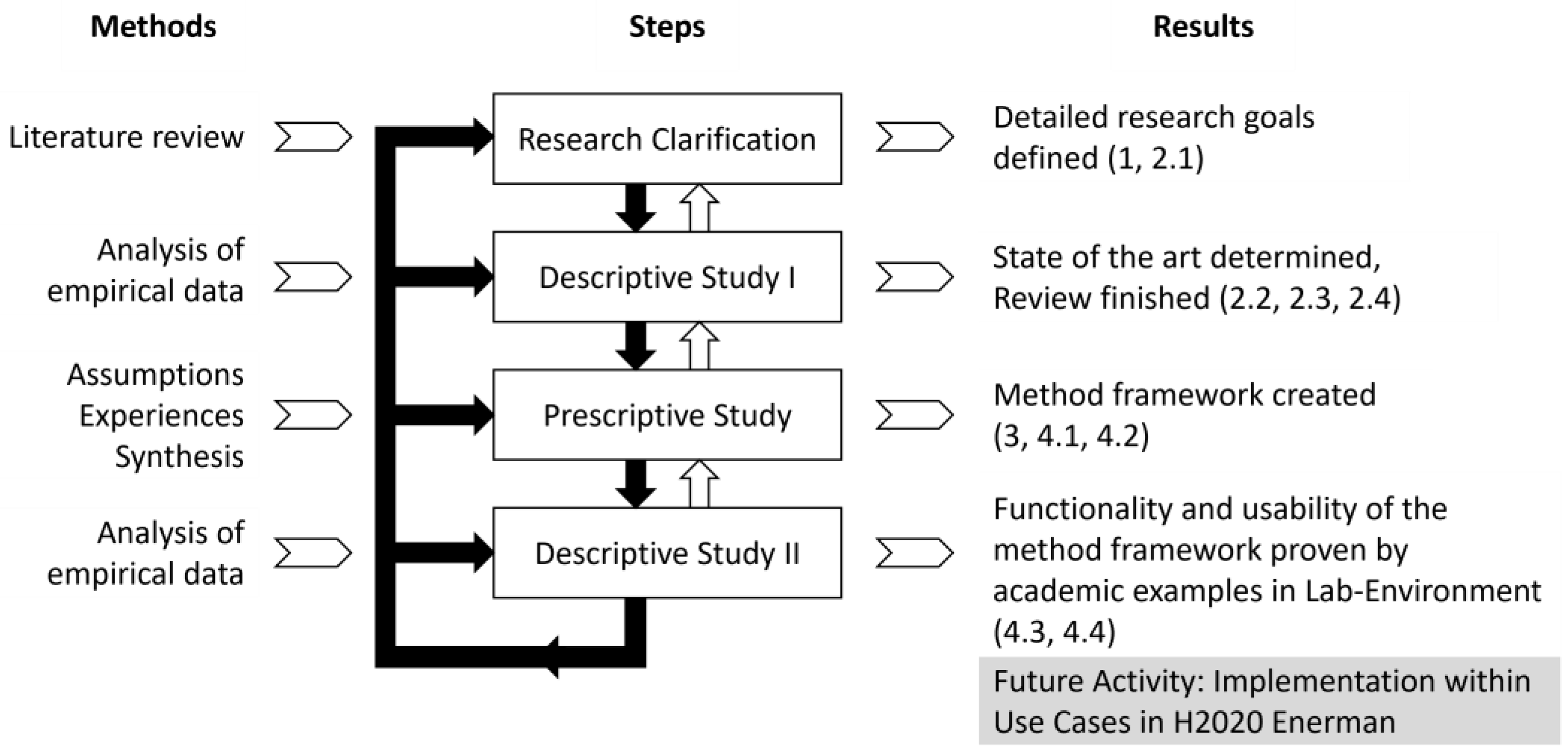
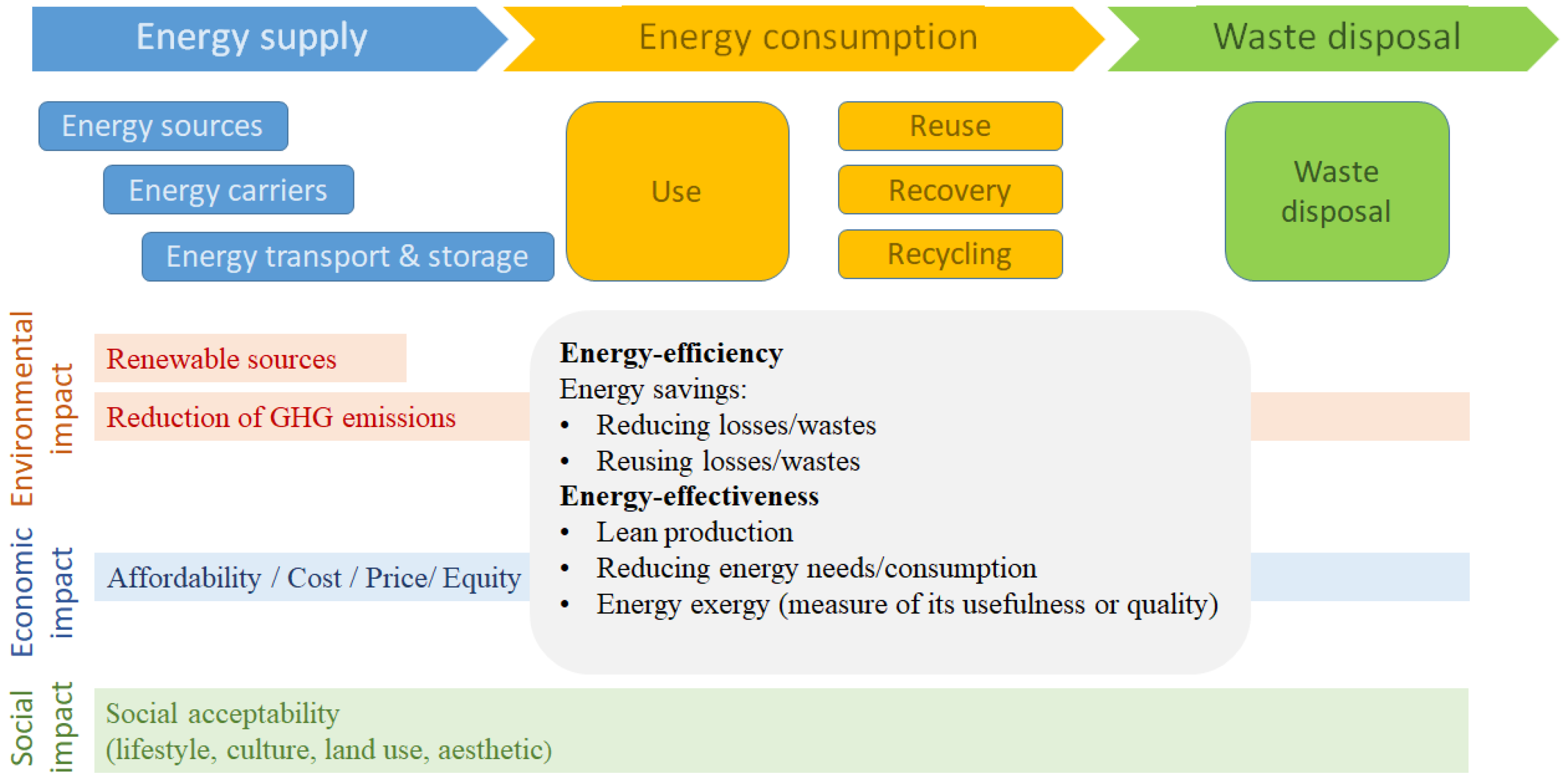

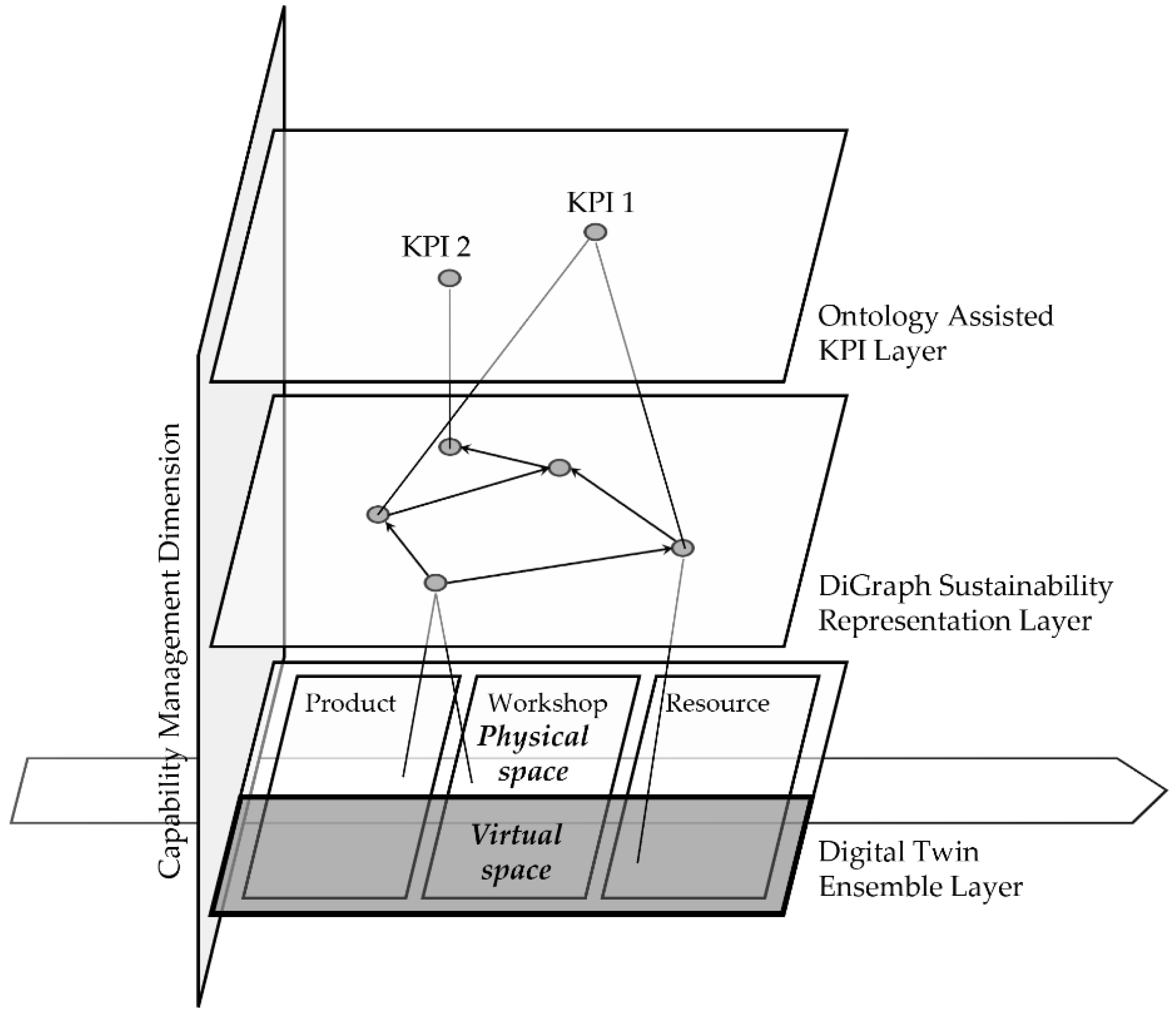


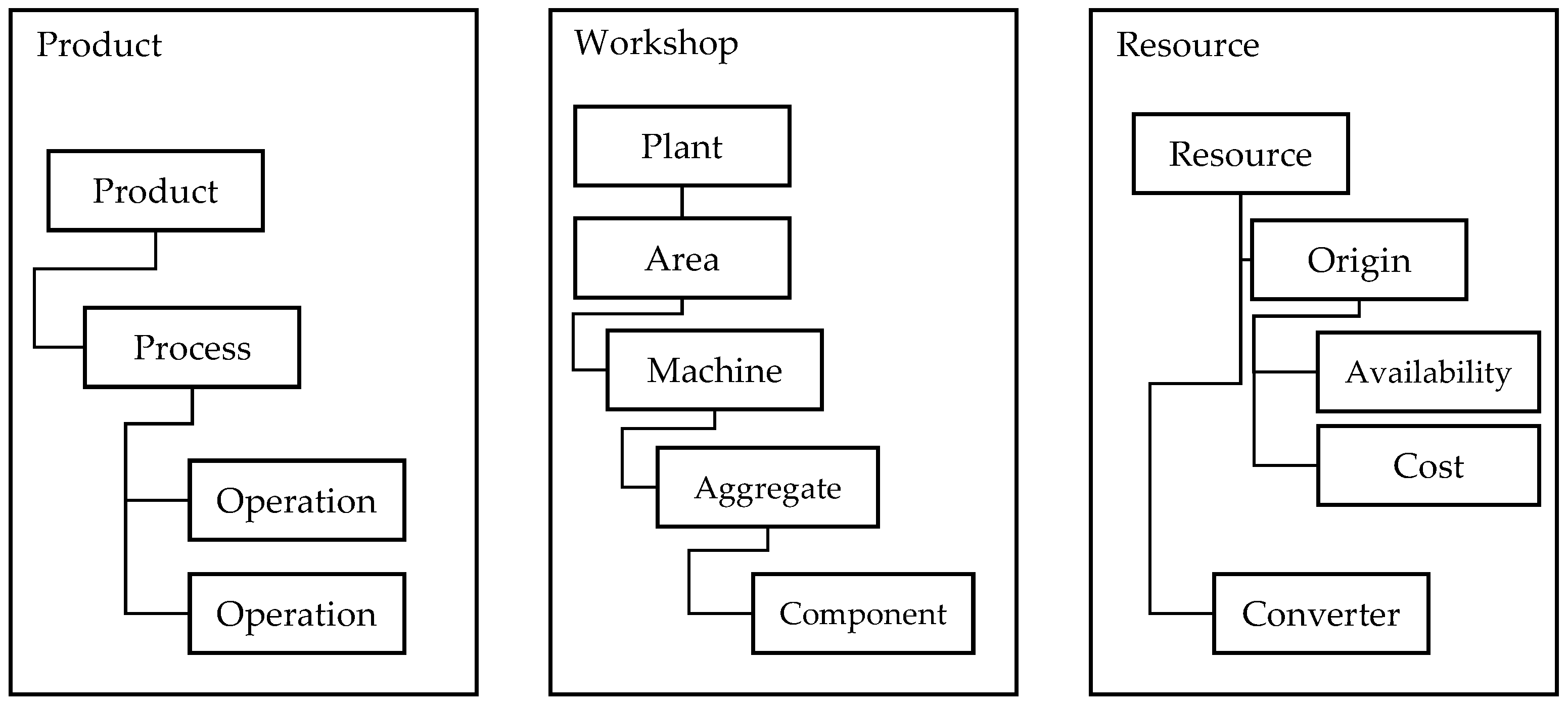
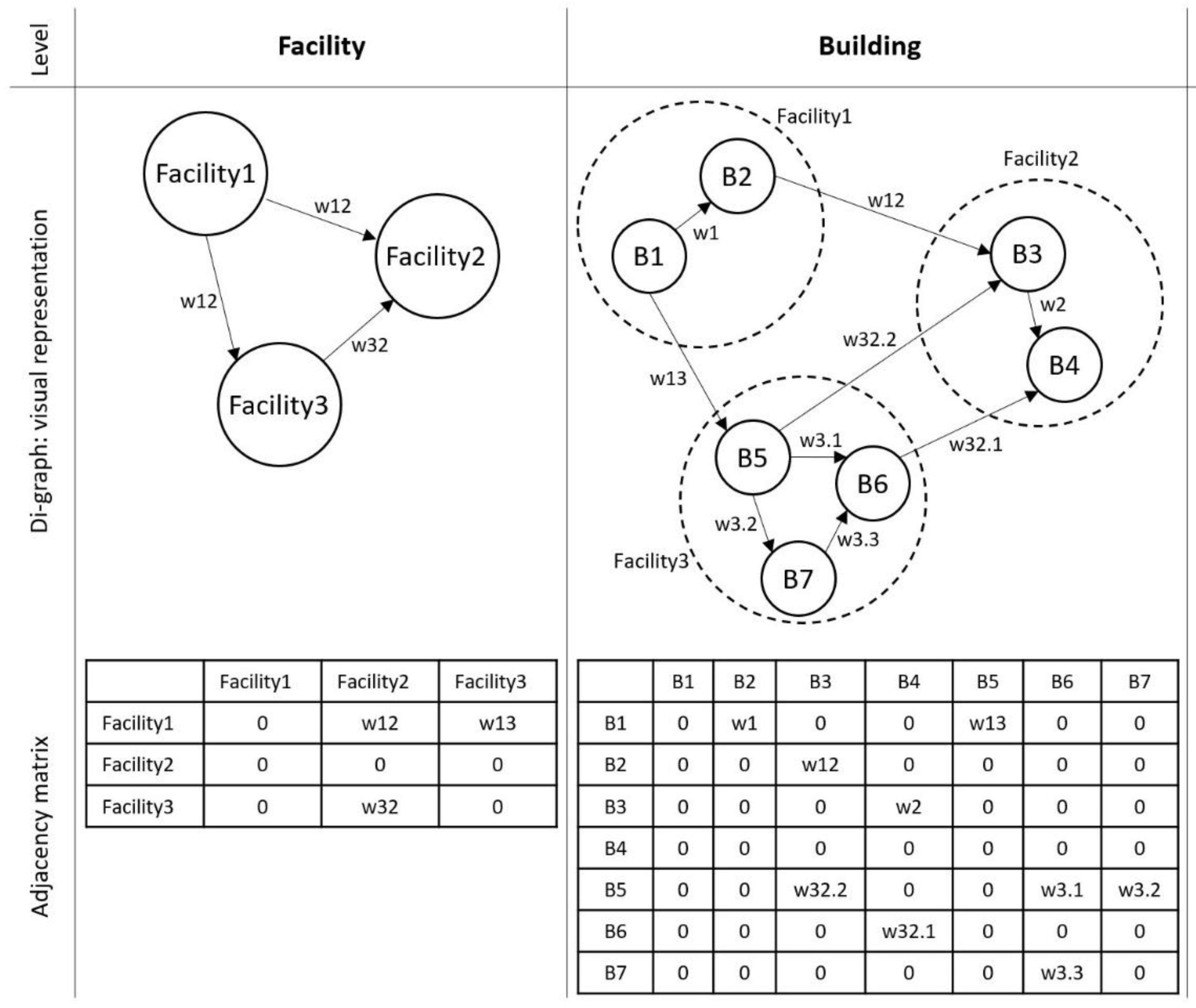
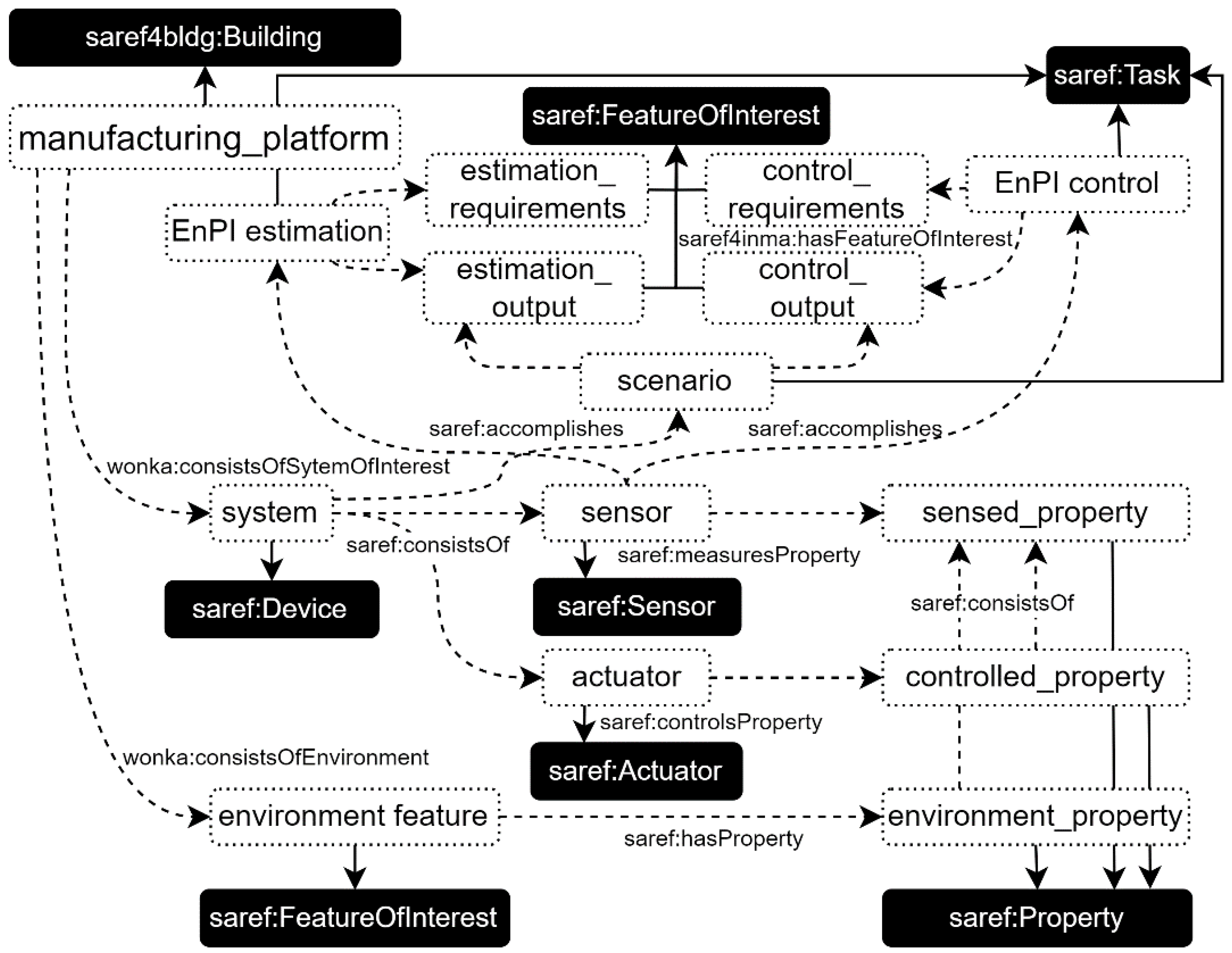

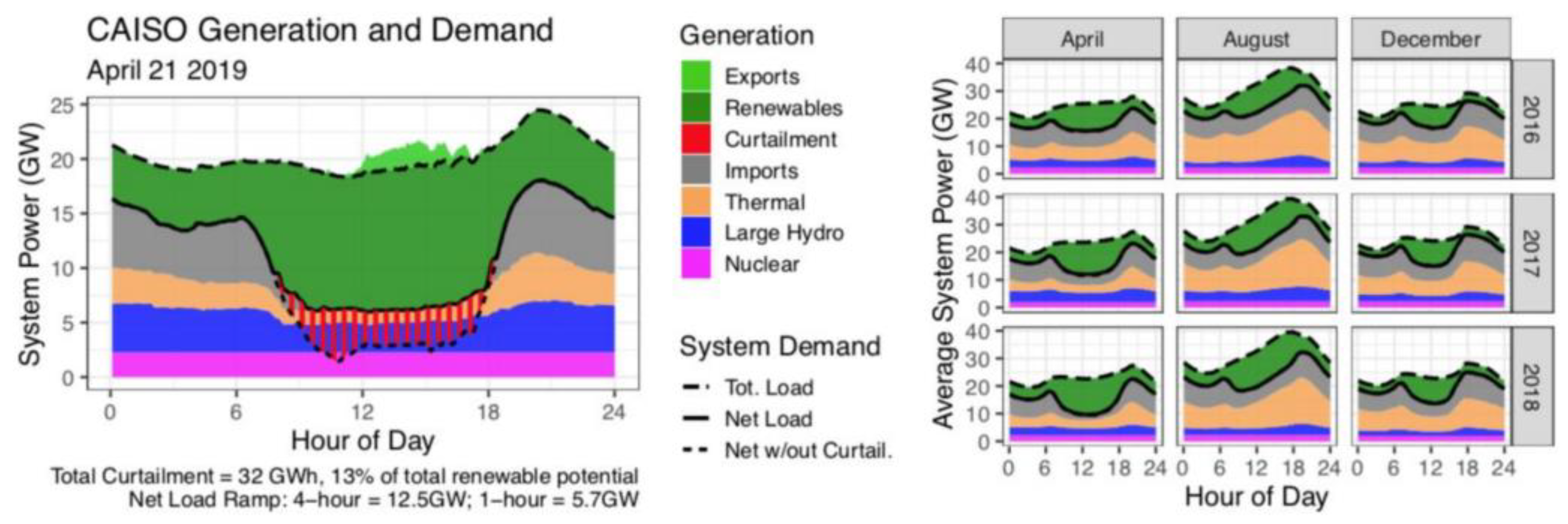
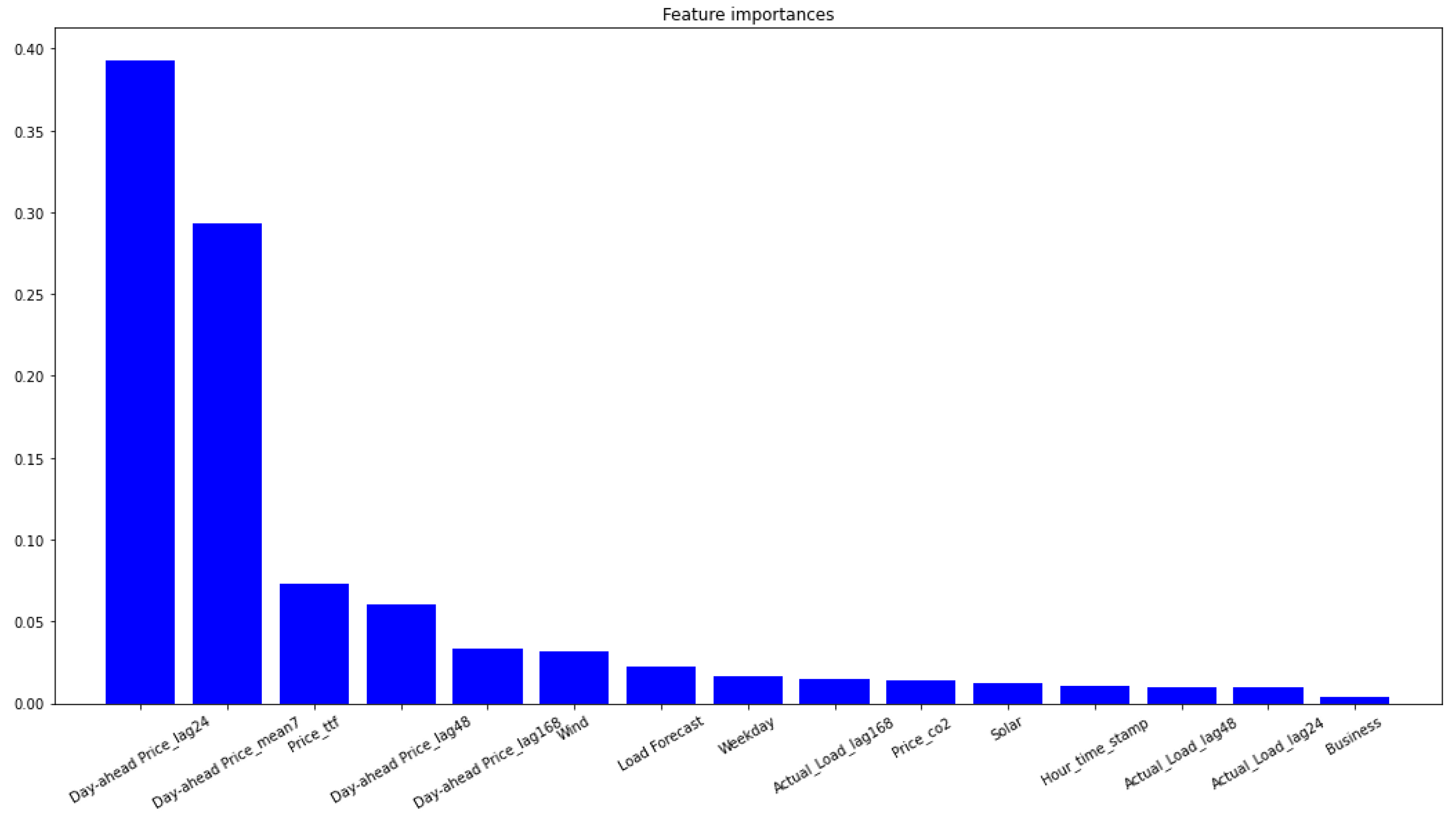
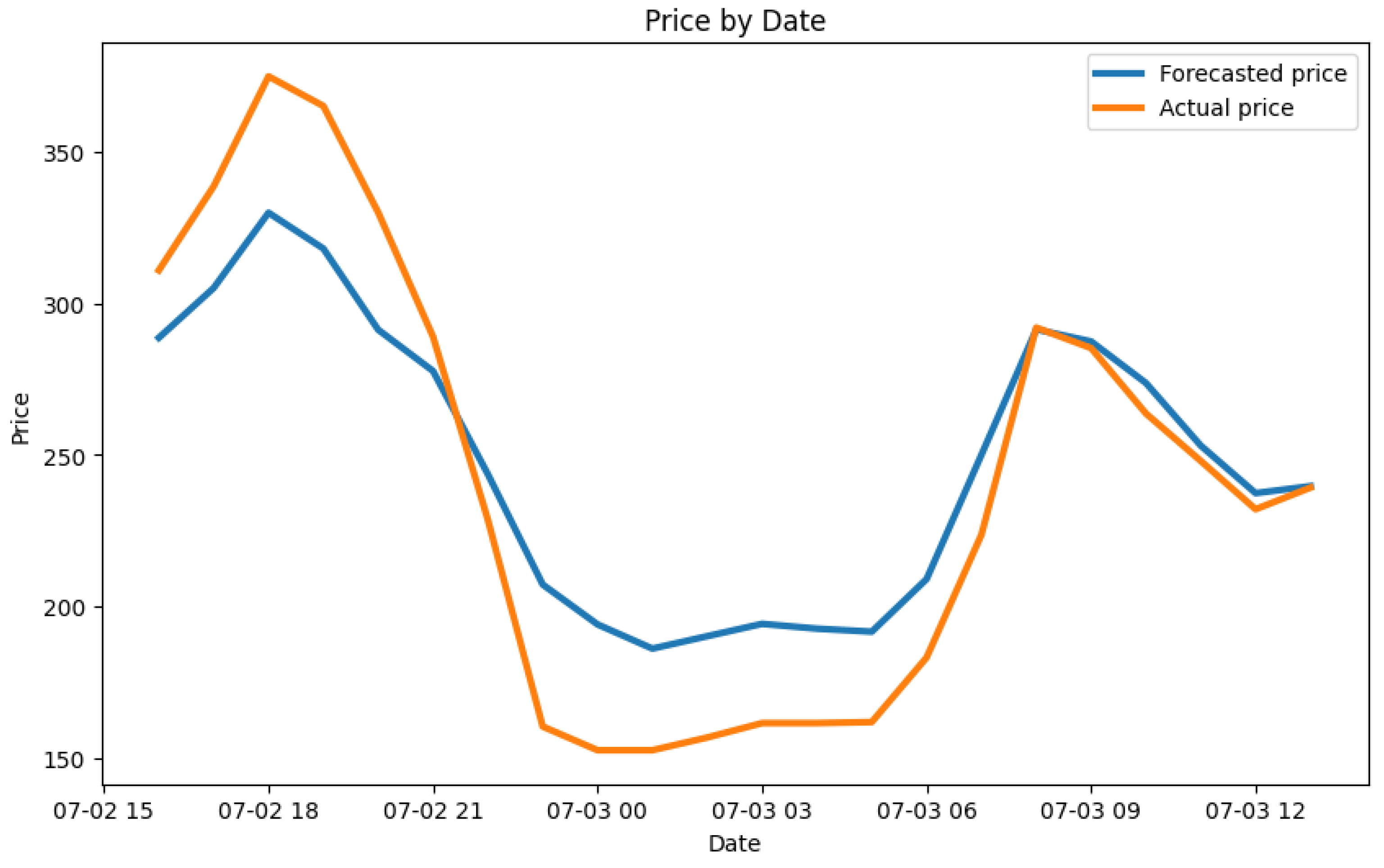
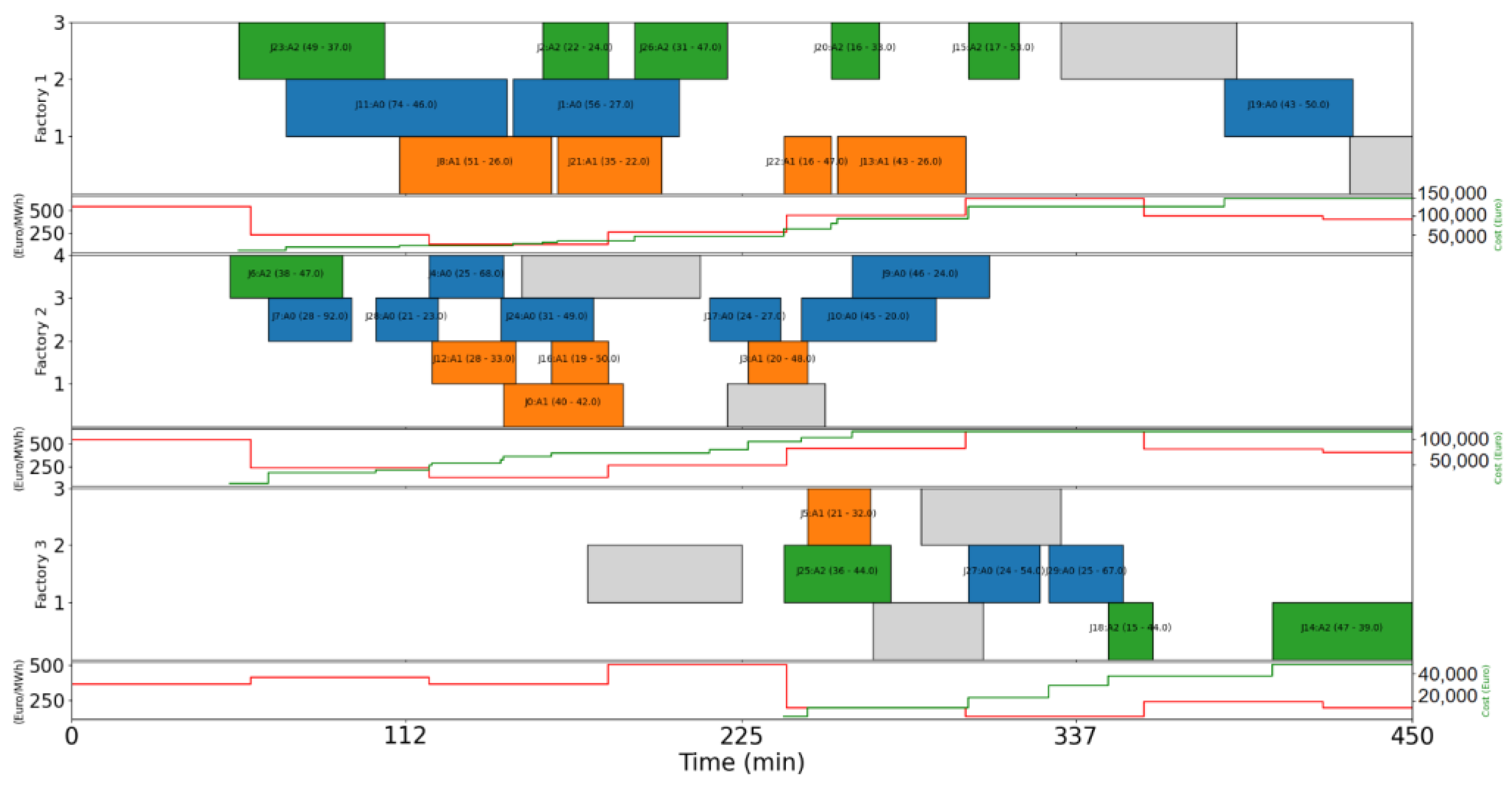
| Level Nature | Plant | Production Line | Machine or Sub-Systems |
|---|---|---|---|
| Energy Performance/Technical | Energy reuse, recycling Green Supply Chain Circular economy | Cycle time | Efficiency/Energy heat losses Energy load profile Performance |
| Energy Consumption (EC) and related expressions (OEE/EC; EC/Product; EC/line) | |||
| Economic | Energy costs Energy sufficiency Energy generation Waste costs | Energy investment cost | Efficiency (i.e., energy cost/unit of product) |
| Environmental | Energy sources (renewable or not) CO2 emission | ||
| Driver | Residential | Industrial |
|---|---|---|
| Type of technology | Smart meter Home automation systems Renewable energy systems | Building management systems Industrial control systems Power monitoring and control systems Process planning and scheduling Renewable energy systems |
| Key performance indicators | Energy costs User comfort (e.g., [34,43]) | Energy sustainability (cf. Table 1) Energy costs Energy consumption |
| Process dependencies | Largely independent appliances | Often interdependent process sequences and jobs |
| User involvement | High-level inclusion of homeowner | Low-level inclusion of specialists |
| Requirement | Related Question for Query |
|---|---|
| Req 1 | For each EnPI within a system of interest, is there at least one sensor monitoring the corresponding required observable properties? |
| Req 2 | For the sake of EnPI estimation accuracy, does each sensor measurement respect Shannon’s theorem, i.e., does each acquisition system have a sampling rate at least twice the maximum frequency of the signals it monitors ? |
| Req 3 | For reliability sake, are all the external factors affecting the considered EnPIs either measured or estimated? (e.g., ambient temperature, etc.) |
| Req 4 | Is there at least one implementable control loop (a collection of actuators, controllers and acquisition systems) capable of controlling the considered EnPI? |
Disclaimer/Publisher’s Note: The statements, opinions and data contained in all publications are solely those of the individual author(s) and contributor(s) and not of MDPI and/or the editor(s). MDPI and/or the editor(s) disclaim responsibility for any injury to people or property resulting from any ideas, methods, instructions or products referred to in the content. |
© 2023 by the authors. Licensee MDPI, Basel, Switzerland. This article is an open access article distributed under the terms and conditions of the Creative Commons Attribution (CC BY) license (https://creativecommons.org/licenses/by/4.0/).
Share and Cite
Hehenberger, P.; Leherbauer, D.; Penas, O.; Delabeye, R.; Patalano, S.; Vitolo, F.; Rega, A.; Alefragis, P.; Birbas, M.; Birbas, A.; et al. Holistic System Modelling and Analysis for Energy-Aware Production: An Integrated Framework. Systems 2023, 11, 100. https://doi.org/10.3390/systems11020100
Hehenberger P, Leherbauer D, Penas O, Delabeye R, Patalano S, Vitolo F, Rega A, Alefragis P, Birbas M, Birbas A, et al. Holistic System Modelling and Analysis for Energy-Aware Production: An Integrated Framework. Systems. 2023; 11(2):100. https://doi.org/10.3390/systems11020100
Chicago/Turabian StyleHehenberger, Peter, Dominik Leherbauer, Olivia Penas, Romain Delabeye, Stanislao Patalano, Ferdinando Vitolo, Andrea Rega, Panayiotis Alefragis, Michael Birbas, Alexios Birbas, and et al. 2023. "Holistic System Modelling and Analysis for Energy-Aware Production: An Integrated Framework" Systems 11, no. 2: 100. https://doi.org/10.3390/systems11020100







